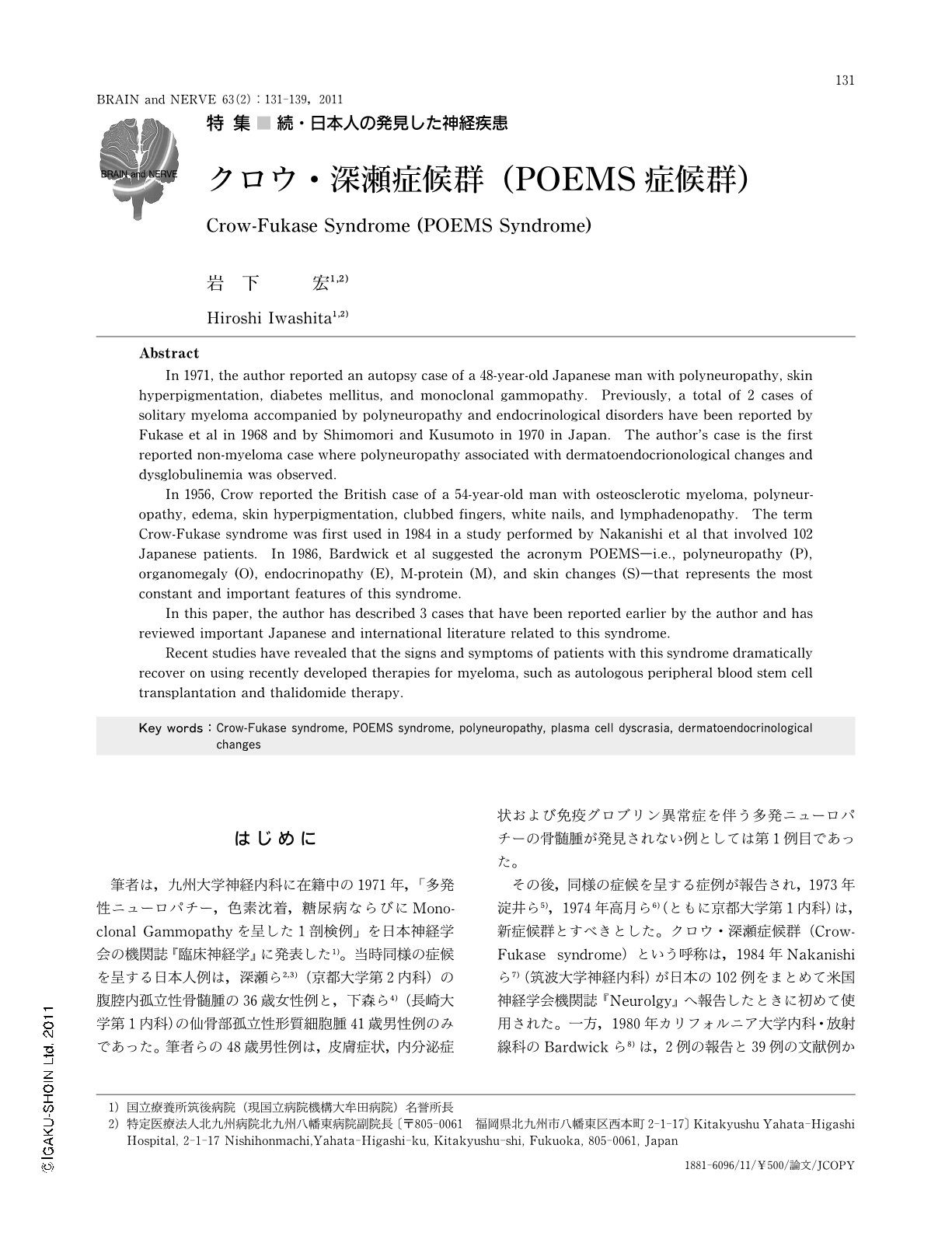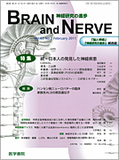Japanese
English
- 有料閲覧
- Abstract 文献概要
- 1ページ目 Look Inside
- 参考文献 Reference
はじめに
筆者は,九州大学神経内科に在籍中の1971年,「多発性ニューロパチー,色素沈着,糖尿病ならびにMonoclonal Gammopathyを呈した1剖検例」を日本神経学会の機関誌『臨床神経学』に発表した1)。当時同様の症候を呈する日本人例は,深瀬ら2,3)(京都大学第2内科)の腹腔内孤立性骨髄腫の36歳女性例と,下森ら4)(長崎大学第1内科)の仙骨部孤立性形質細胞腫41歳男性例のみであった。筆者らの48歳男性例は,皮膚症状,内分泌症状および免疫グロブリン異常症を伴う多発ニューロパチーの骨髄腫が発見されない例としては第1例目であった。
その後,同様の症候を呈する症例が報告され,1973年淀井ら5),1974年高月ら6)(ともに京都大学第1内科)は,新症候群とすべきとした。クロウ・深瀬症候群(Crow-Fukase syndrome)という呼称は,1984年Nakanishiら7)(筑波大学神経内科)が日本の102例をまとめて米国神経学会機関誌『Neurolgy』へ報告したときに初めて使用された。一方,1980年カリフォルニア大学内科・放射線科のBardwickら8)は,2例の報告と39例の文献例から,本症候群の重要項目としてpolyneuropathy(P),organomegaly(O),endocrinopathy(E),M-proteins(M)およびskin changes(S)をとりあげ,POEMS症候群という呼び方を提案した。
筆者は,1971年の発表後,数例を経験し,いくつかの研究論文を発表した9-13)。その後,本症候群には,1996年Watanabeら14)(鹿児島大学第3内科)によって血管内皮増殖因子(vascular endothelial growth factor:VEGF)が上昇していることが報告され,最近では桑原のグループ15-17)(千葉大学神経内科)によって治療の進歩が報告され,改めて注目されている。
本稿では,筆者らが報告した初期の症例を再提示するとともに,本症候群に関する主な研究論文を再点検した結果を記すことにする。
Abstract
In 1971, the author reported an autopsy case of a 48-year-old Japanese man with polyneuropathy, skin hyperpigmentation, diabetes mellitus, and monoclonal gammopathy. Previously, a total of 2 cases of solitary myeloma accompanied by polyneuropathy and endocrinological disorders have been reported by Fukase et al in 1968 and by Shimomori and Kusumoto in 1970 in Japan. The author's case is the first reported non-myeloma case where polyneuropathy associated with dermatoendocrionological changes and dysglobulinemia was observed. In 1956, Crow reported the British case of a 54-year-old man with osteosclerotic myeloma, polyneuropathy, edema, skin hyperpigmentation, clubbed fingers, white nails, and lymphadenopathy. The term Crow-Fukase syndrome was first used in 1984 in a study performed by Nakanishi et al that involved 102 Japanese patients. In 1986, Bardwick et al suggested the acronym POEMS―i.e., polyneuropathy (P), organomegaly (O), endocrinopathy (E), M-protein (M), and skin changes (S)―that represents the most constant and important features of this syndrome. In this paper, the author has described 3 cases that have been reported earlier by the author and has reviewed important Japanese and international literature related to this syndrome. Recent studies have revealed that the signs and symptoms of patients with this syndrome dramatically recover on using recently developed therapies for myeloma,such as autologous peripheral blood stem cell transplantation and thalidomide therapy.

Copyright © 2011, Igaku-Shoin Ltd. All rights reserved.


